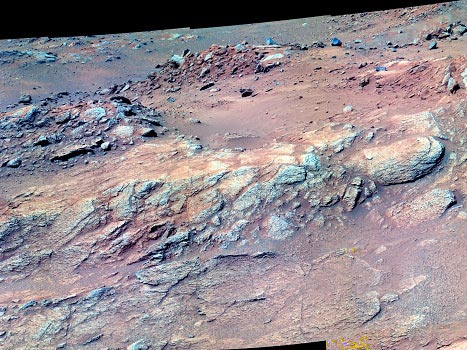3
Methuselah in False Color 5/24/05
 An outcrop dubbed "Methuselah," approached by NASA's Mars Exploration Rover Spirit in April 2005, presented a more extensive exposure of layered rock than Spirit had found in the all its preceding 15 months since landing on Mars. This view of Methuselah by Spirit's panoramic camera is presented in false color. Image Credit: NASA/JPL/Cornell
An outcrop dubbed "Methuselah," approached by NASA's Mars Exploration Rover Spirit in April 2005, presented a more extensive exposure of layered rock than Spirit had found in the all its preceding 15 months since landing on Mars. This view of Methuselah by Spirit's panoramic camera is presented in false color. Image Credit: NASA/JPL/Cornell
Space Shuttle Columbia
Space Shuttle Columbia Shuttle Orbiter Columbia (NASA Designation: OV-102) was the first space shuttle in NASA's orbital fleet, first flying mission STS-1 from April 12 to April 14, 1981. It was lost with all crew when it disintegrated during re-entry on its 28th mission, STS-107, which lasted from January 16 to February 1, 2003. Table of contents showTocToggle("show","hide") 1 History 2 Final Mission 3 Cultural Reaction 4 Missions 5 Related articles 6
The answer within those groups dedicated to the shuttle was to show that as long as you have enough launches, the development cost of the system would be overwhelmed by the cost of the rockets you would otherwise throw away. One factor that needs to be considered is inflation though, and in the 1970s this was high enough that the payback from the development had to happen very quickly or that money would never pay for itself. In other words you needed a very high launch rate to make the system work.
HAL/S
computer language, best known for its use in the Space Shuttle. It was written by Intermetrics in the 1970s for NASA. HAL/S is written in a dialect of PL/I known as XPL The three key factors in writing the language were reliability, efficiency, and machine-independence. The language is designed to allow tasks such as performing aerospace related vector/matrix arithmetic to be accomplished in a way that is easily understandable to people who have studied the subject. HAL/S is written without functions (such as GOTO in BASIC) that are known to be the cause of many errors. There are no abreviations for keywords, and keywords are all reserved so that they cannot also be used as variables. Considerations such as this are designed to reduce the chances of errors occurring, and also
International Space Station
International Space Station Continuing on from the United States' Skylab and Russia's Mir, the International Space Station (ISS) represents a permanent human presence in space. The space station is located in orbit around the Earth at an altitude of approximately 386 km, a type of orbit usually termed low Earth orbit. (The actual height varies over time by several kilometres due to atmospheric drag and reboosts.) It orbits Earth at a period of about 92 minutes; on December 1, 2003 it had completed over 28,700 orbits since launch. It is serviced primarily by the Space Shuttle, and Soyuz and Progress spacecraft units. It is still being built, but is home to some experimentation already. At present, the station has a capacity for a crew of three, who
Kalpana Chawla
(July 1, 1961 - February 1, 2003) was an astronaut and space shuttle mission specialist of STS-107 (Columbia) who was killed when the craft disintegrated after reentry into the Earth's atmosphere. Kalpana Chawla Table of contents showTocToggle("show","hide") 1 Early Life 2 Education 3 NASA Career 4 Personal Characteristics 5 Memoria 6 See also 7 External Links Early Life Chawla was born in Karnal, Haryana, India. Her interest in flight was inspired by J. R. D. Tata, India's first pilot. Education Chawla studied aeronautical engineering at the Punjab Engineering College in Punjab, India in 1982 where she earned her Bachelor of Science degree. Thereafter she moved to the United States to obtain a Master of Science degree in aerospace engineering from University of Texas (1984). Dr. Chawla earned a doctorate in aerospace
X-Prize
two weeks. This must be essentially the same vehicle: propellant can be replaced, but most of the rest of the vehicle must be reused. Even NASA's space shuttle falls short of this performance requirement, since it takes much more than two weeks to ready a given shuttle between flights. This prize foundation was created to encourage the development of private space travel, which is why government-funded projects are not allowed. The X Prize is designed to help create a space industry, and is modeled after many prizes from the early 20th century that helped prod the development of air flight—notably the $25,000 Orteig Prize that spurred Charles Lindbergh to make his solo flight across the Atlantic Ocean. The X-Prize Foundation (based in St. Louis, Missouri) maintains a list of organizations registered
With a baseline project now gelling, NASA started to work though the process of obtaining stable funding for the five years the project would take to develop. Here too they found themselves increasingly backed into a corner.
Hubble Space Telescope
Hubble Space Telescope The Hubble Space Telescope (HST, or Hubble) is a telescope located at the outer edges of Earth's atmosphere, about 600 kilometerss above the ground, orbiting the Earth every 100 minutes. It was placed into orbit, in April 1990, as a joint project of NASA and the ESA. The telescope can achieve optical resolutions greater than 0.1 arcseconds. The HST is named after Edwin Hubble. It is scheduled for replacement, by the James Webb Space Telescope (JWST), in 2009. Every day, the Hubble Space Telescope archives 3 to 5 gigabytes of data and delivers between 10 and 15 gigabytes to astronomers. Working outside the atmosphere has advantages because the atmosphere obscures images and filters out electromagnetic radiation at certain wavelengths, mainly in the infrared. Hubble

